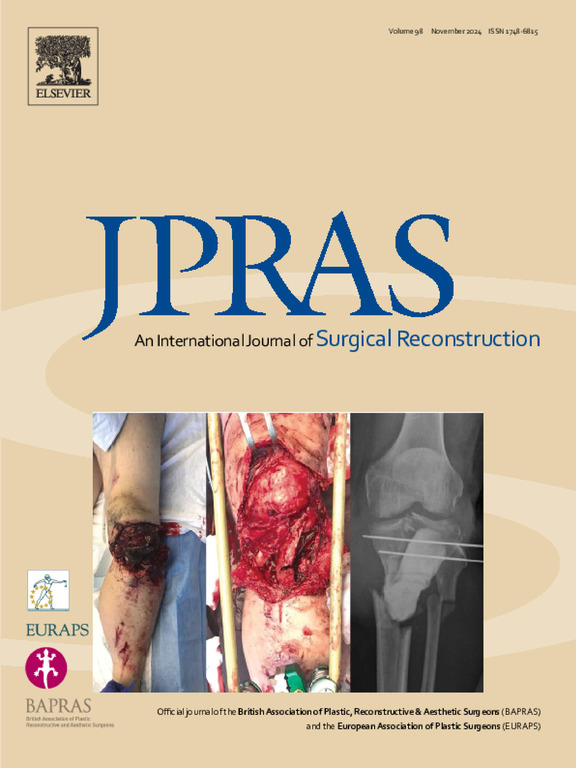利用外科数据库研究中缝合类型颅缝闭合的新诊断代码
IF 2.4
3区 医学
Q2 SURGERY
Journal of Plastic Reconstructive and Aesthetic Surgery
Pub Date : 2025-07-10
DOI:10.1016/j.bjps.2025.07.008
引用次数: 0
摘要
颅缝闭合症表现多样,影响手术入路和术后结果。本研究应用新的诊断ICD-10代码,根据颅缝愈合缝合类型分层,调查手术数据库中术后结果的趋势。方法在2023年国家外科质量改进计划(NSQIP)儿科数据库中确定采用特定缝合方式修复颅缝闭合的患者。病例以临床合并症和发病年龄为特征。关注的结果是30天的并发症,包括感染、再手术和输血,以及接受内窥镜和开放式修复。结果最终纳入336例患者。最常见的缝合方式是矢状缝合(52.7%),其次是异位缝合(20.2%)。出院时阿片类药物处方率为41.4%。30天并发症发生率最高的是单冠状颅缝闭(12.1%),内窥镜修复率最高的是矢状颅缝闭(16.4%)(p<0.001)。当单缝线与多缝线进行比较时,后者与修复时年龄较大(32.6±35.8比13.0±24.1个月,p=0.011)和手术时间较长(3.7±1.3比2.7±1.7 h, p=0.0013)相关。30天并发症和出院时阿片类药物处方率在两个队列之间无显著差异(p>0.05)。结论新诊断规范的发布有助于确认已知趋势,如不同缝合方式的流行程度和颅缝愈合修复相对于短期并发症的相对安全性,以及确定颅缝愈合研究中需要进一步探索的领域,如全国术后阿片类药物处方趋势。本文章由计算机程序翻译,如有差异,请以英文原文为准。
Leveraging novel diagnostic codes for craniosynostosis by suture type in surgical database research
Background
Craniosynostosis presents with a diverse range of presentations that influence surgical approach and postoperative outcomes. This study applies new diagnostic ICD-10 codes that stratify by craniosynostosis suture type to investigate trends in postoperative outcomes within a surgical database.
Methods
Patients undergoing craniosynostosis repair with specified suture types were identified in the 2023 National Surgical Quality Improvement Program (NSQIP) Pediatric database. Cases were characterized by clinical comorbidities and age at presentation. The outcome of interest was 30-day complications, including infection, reoperation, and blood transfusion, as well as the reception of endoscopic versus open repair.
Results
The final cohort included 336 patients. The most common suture type was sagittal (52.7%), followed by metopic (20.2%). The rate of opioid prescriptions at discharge was 41.4%. Rates of 30-day complications were highest in unicoronal craniosynostosis (12.1%), and rates of endoscopic repair were highest in sagittal craniosynostosis (16.4%) (p<0.001). When comparing single-suture to multisuture involvement, the latter was associated with older age at repair (32.6±35.8 vs. 13.0±24.1 months, p=0.011) and longer operative time (3.7±1.3 vs. 2.7±1.7 h, p=0.0013). Rates of thirty-day complications and opioid prescriptions at discharge were not significantly different between the two cohorts (p>0.05).
Conclusion
The release of new diagnostic codes has allowed for the confirmation of known trends, such as the prevalence of different suture types and the relative safety of craniosynostosis repair with respect to short-term complications, as well as the identification of areas for further exploration, such as national trends in postoperative opioid prescriptions, within craniosynostosis research.
求助全文
通过发布文献求助,成功后即可免费获取论文全文。
去求助
来源期刊
CiteScore
3.10
自引率
11.10%
发文量
578
审稿时长
3.5 months
期刊介绍:
JPRAS An International Journal of Surgical Reconstruction is one of the world''s leading international journals, covering all the reconstructive and aesthetic aspects of plastic surgery.
The journal presents the latest surgical procedures with audit and outcome studies of new and established techniques in plastic surgery including: cleft lip and palate and other heads and neck surgery, hand surgery, lower limb trauma, burns, skin cancer, breast surgery and aesthetic surgery.

 求助内容:
求助内容: 应助结果提醒方式:
应助结果提醒方式:


